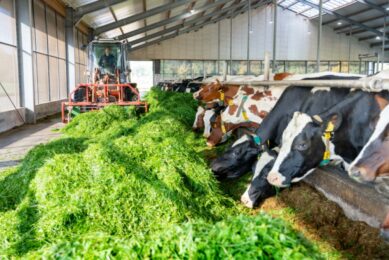How the US dairy sector is driving environmental progress

A Net Zero Initiative was recently unveiled by the Innovation Center for US Dairy in an effort to assist dairy farmers implementing new technologies.
Signaling bold climate change action, the Innovation Center for US Dairy unveiled the Net Zero Initiative, an industry-wide effort that will help US dairy farms of all sizes and geographies implement new technologies and adopt economically viable practices. The initiative is a critical component of US dairy’s environmental stewardship goals, endorsed by dairy industry leaders and farmers, to achieve carbon neutrality, optimised water usage and improved water quality by 2050, according to a recent press release.

“The US dairy community has been working together to provide the world with responsibly-produced, nutritious dairy foods,” said Mike Haddad, chairman of the Innovation Center for US Dairy. “With the entire dairy community at the table – from farmers and cooperatives to processors, household brands and retailers – we’re leveraging US dairy’s innovation, diversity and scale to drive continued environmental progress and create a more sustainable planet for future generations.”
Supporting and enabling farmers through the Net Zero Initiative has the potential to transform the dairy industry.”
Partnership with Nestlé
The Innovation Center for U.S. Dairy also announced a key milestone on its journey toward carbon neutrality – an up to US$10 million commitment and multi-year partnership with Nestlé to support the Net Zero Initiative and scale access to environmental practices and resources on farms across the country.
“Supporting and enabling farmers through the Net Zero Initiative has the potential to transform the dairy industry,” said Jim Wells, chief supply chain officer for Nestlé USA. “Scaling up climate-smart agricultural initiatives is key to Nestlé’s ambition to achieve net zero greenhouse gas emissions by 2050 and will help reduce the carbon footprint of many of our brands. We are excited to collaborate with US dairy and our suppliers to contribute to an even more sustainable dairy supply chain.”
 Finding ways to reduce ammonia emissions on dairy farms
Finding ways to reduce ammonia emissions on dairy farms
Livestock-heavy countries around the world are under pressure to reduce their ammonia emissions. We look at methods that can reduce these emissions.
Bringing Net Zero to Life
The Net Zero Initiative is a collaboration of dairy organisations and represents a critical pathway on U.S. dairy’s sustainability journey. Many of the practices and technologies needed to reach the industry’s goals largely exist but require further research and development and overall greater accessibility across farms of all sizes and geographies. Through foundational science, on-farm pilots and the development of new product markets, the Net Zero Initiative aims to knock down barriers and create incentives for farmers that will lead to economic viability and positive environmental impact.
“As part of a 5th-generation dairy farming family, we pride ourselves on sustaining our land, caring for our animals and preserving our business for the next generation,” said Tara Vander Dussen, a New Mexico dairy farmer. “We want to be at the table, testing new practices and accessing innovative technology to go further, faster. Because in the end, we all want the same thing – a healthy planet for our families and our children.”
 Sustainability initiatives: For now and the future
Sustainability initiatives: For now and the future
Sustainability is an incredibly important concept these days, due to increasing global awareness of the limited resources to feed our growing population.
Nestlé is the first of what the U.S. dairy community hopes will be many partners joining the Net Zero Initiative, contributing funding and expertise to help propel the entire industry’s progress toward a more sustainable future. With brands like Carnation, Stouffer’s and DiGiorno, Nestlé brings a wealth of knowledge and industry leadership to the table, and an earnest commitment to supporting US dairy farmers in environmental advancements and technology adoption. “We know a lot more is possible – proven science and evidence from dairy’s existing best practices tells us we can get to net zero,” added Haddad.
Source and for more information: US Dairy
Join 13,000+ subscribers
Subscribe to our newsletter to stay updated about all the need-to-know content in the dairy sector, two times a week.










